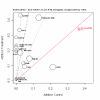Assessing differential attrition in clinical trials: self-monitoring of oral anticoagulation and type II diabetes
- PMID: 17474976
- PMCID: PMC1876242
- DOI: 10.1186/1471-2288-7-18
Assessing differential attrition in clinical trials: self-monitoring of oral anticoagulation and type II diabetes
Abstract
Background: Analyzing drop out rates and when they occur may give important information about the patient characteristics and trial characteristics that affect the overall uptake of an intervention.
Methods: We searched Medline and the Cochrane library from the beginning of the databases to May 2006 for published systematic reviews that compared the effects of self-monitoring (self-testing) or self-management (self-testing and self-dosage) of oral anticoagulation or self-monitored blood glucose in type 2 diabetics who were not using insulin. We assessed all study withdrawals pre-randomization and post randomization and sought information on the reasons for discontinuation of all participants.To measure the differential between groups in attrition we used the relative attrition (RA), which is equivalent to relative risk but uses attrition as the outcome (i.e. attrition in intervention group/attrition in control group). We determined the percentage drop outs for control and intervention groups and used DerSimonian and Laird random effects models to estimate a pooled relative attrition. L'abbe type plots created in R (version 2.0.2) were used to represent the difference in the relative attrition among the trials with 95% confidence areas and weights derived from the random effects model.
Results: With self-monitoring of blood glucose in type 2 diabetes, attrition ranged from 2.3% to 50.0% in the intervention groups and 0% to 40.4% in the control groups. There was no significant difference between the intervention and control, with an overall RA of 1.18 [95% CI, 0.70-2.01]. With self-monitoring of oral anticoagulation attrition ranged from 0% to 43.2% in the intervention groups and 0% to 21.4% in the control group. The RA was significantly greater in the intervention group, combined RA, 6.05 [95% CI, 2.53-14.49].
Conclusion: This paper demonstrates the use of relative attrition as a new tool in systematic review methodology which has the potential to identify patient, intervention and trial characteristics which influences attrition in trials.
Figures
Similar articles
-
Assessing the impact of attrition in randomized controlled trials.J Clin Epidemiol. 2010 Nov;63(11):1264-70. doi: 10.1016/j.jclinepi.2010.01.010. Epub 2010 Jun 22. J Clin Epidemiol. 2010. PMID: 20573482
-
Individual patient data meta-analysis of trials of self-monitoring of blood glucose in non-insulin treated type 2 diabetes: protocol for a systematic review.Prim Care Diabetes. 2009 May;3(2):117-21. doi: 10.1016/j.pcd.2009.03.002. Epub 2009 Apr 16. Prim Care Diabetes. 2009. PMID: 19375398
-
Individual patient meta-analysis of self-monitoring of an oral anticoagulation protocol.J Heart Valve Dis. 2008 Mar;17(2):233-8. J Heart Valve Dis. 2008. PMID: 18512497
-
Self-monitoring of blood glucose in patients with diabetes who do not use insulin--are guidelines evidence-based?Diabet Med. 2012 Oct;29(10):1226-36. doi: 10.1111/j.1464-5491.2012.03659.x. Diabet Med. 2012. PMID: 22435892 Review.
-
Percent total attrition: a poor metric for study rigor in hosted intervention designs.Am J Public Health. 2009 Sep;99(9):1567-75. doi: 10.2105/AJPH.2008.134767. Epub 2009 Jul 16. Am J Public Health. 2009. PMID: 19608965 Free PMC article. Review.
Cited by
-
Supporting patients to self-monitor their oral anticoagulation therapy: recommendations based on a qualitative study of patients' experiences.Br J Gen Pract. 2015 Jul;65(636):e438-46. doi: 10.3399/bjgp15X685645. Epub 2015 Jun 15. Br J Gen Pract. 2015. PMID: 26077266 Free PMC article.
-
A brief couples' workshop for improving sexual experiences after prostate cancer treatment: a feasibility study.Support Care Cancer. 2013 Dec;21(12):3403-9. doi: 10.1007/s00520-013-1922-4. Epub 2013 Aug 10. Support Care Cancer. 2013. PMID: 23934226
-
Self-monitoring of blood glucose in type 2 diabetes: a new look at published trials.Diabetologia. 2008 Apr;51(4):686-8. doi: 10.1007/s00125-008-0946-7. Epub 2008 Feb 20. Diabetologia. 2008. PMID: 18286256 No abstract available.
-
Missing data in randomized controlled trials testing palliative interventions pose a significant risk of bias and loss of power: a systematic review and meta-analyses.J Clin Epidemiol. 2016 Jun;74:57-65. doi: 10.1016/j.jclinepi.2015.12.003. Epub 2015 Dec 21. J Clin Epidemiol. 2016. PMID: 26718729 Free PMC article.
-
Impact of MyDiabetesPlan, a Web-Based Patient Decision Aid on Decisional Conflict, Diabetes Distress, Quality of Life, and Chronic Illness Care in Patients With Diabetes: Cluster Randomized Controlled Trial.J Med Internet Res. 2020 Sep 30;22(9):e16984. doi: 10.2196/16984. J Med Internet Res. 2020. PMID: 32996893 Free PMC article. Clinical Trial.
References
-
- Guerci B, Drouin P, Grange V, Bougneres P, Fontaine P, Kerlan V, Passa P, Thivolet C, Vialettes B, Charbonnel B. Self-monitoring of blood glucose significantly improves metabolic control in patients with type 2 diabetes mellitus: the Auto-Surveillance Intervention Active (ASIA) study. Diabetes Metab. 2003;29:587–594. doi: 10.1016/S1262-3636(07)70073-3. - DOI - PubMed
Publication types
MeSH terms
Substances
LinkOut - more resources
Full Text Sources
Medical





